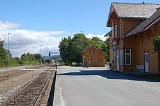
Hell Station
Encyclopedia
Hell Station is a railway station
located in the village of Hell in the municipality of Stjørdal
in Nord-Trøndelag
county, Norway
. It is located at the intersection of the Nordland Line and Meråker Line.
The station was first constructed in 1881, though the present station building was opened in 1902. The station is served by the Trøndelag Commuter Rail system in addition to regional trains between Trondheim Central Station
and Östersund
on the Meråker Line, Mittnabotåget
. Both services are operated by Class 92 units by the Norwegian State Railways (NSB), Norway's public railway company.
 The restaurant was taken over by Norsk Spisevognselskap
The restaurant was taken over by Norsk Spisevognselskap
on 1 October 1922, but returned to private operation in 1934.
, the afterlife of punishment to which, according to religious belief, sinners or heathens are condemned upon death. The name derives from Old Norse
, which means cave. In present-day Norwegian
, means luck
and means "at an end".
The station's freight building still bears the sign saying , which simply means "freight service" or "cargo handling", which is the archaic spelling (in contemporary Norwegian it would be spelled ). The sign is a popular photo opportunity for tourists, Norwegian and foreign alike.
Train station
A train station, also called a railroad station or railway station and often shortened to just station,"Station" is commonly understood to mean "train station" unless otherwise qualified. This is evident from dictionary entries e.g...
located in the village of Hell in the municipality of Stjørdal
Stjørdal
is a municipality in Nord-Trøndelag county, Norway. It is part of the Stjørdalen region. The administrative centre of the municipality is the town of Stjørdal, also called Stjørdalshalsen...
in Nord-Trøndelag
Nord-Trøndelag
is a county constituting the northern part of Trøndelag in Norway. As of 2010, the county had 131,555 inhabitants, making it the country's fourth-least populated county. The largest municipalities are Stjørdal, Steinkjer—the county seat, Levanger, Namsos and Verdal, all with between 21,000 and...
county, Norway
Norway
Norway , officially the Kingdom of Norway, is a Nordic unitary constitutional monarchy whose territory comprises the western portion of the Scandinavian Peninsula, Jan Mayen, and the Arctic archipelago of Svalbard and Bouvet Island. Norway has a total area of and a population of about 4.9 million...
. It is located at the intersection of the Nordland Line and Meråker Line.
The station was first constructed in 1881, though the present station building was opened in 1902. The station is served by the Trøndelag Commuter Rail system in addition to regional trains between Trondheim Central Station
Trondheim Central Station
Trondheim Central Station or Trondheim S is the main railway station serving the city of Trondheim, Norway. Located at Brattøra in the north part of the city center, it is the terminus of the Dovre Line, running southwards, and the Nordland Line, which runs north...
and Östersund
Östersund
Östersund is an urban area in Jämtland in the middle of Sweden. It is the seat of Östersund Municipality and the capital of Jämtland County. Östersund is located at the shores of Sweden's fifth largest lake, Storsjön, opposite the island Frösön, and is the only city in Jämtland. Östersund is the...
on the Meråker Line, Mittnabotåget
Mittnabotåget
Mittnabotåget is a regional train service connecting Trondheim in Norway with Sundsvall in Sweden. It includes trains operated by Veolia Transport on the Mittlinjen between Sundsvall and Östersund in Sweden, and Norges Statsbaner’s cross-border Nabotåget services from Östersund on to Trondheim in...
. Both services are operated by Class 92 units by the Norwegian State Railways (NSB), Norway's public railway company.

Norsk Spisevognselskap
Norsk Spisevognselskap A/S, often abbreviated NSS or shortened to Spisevognselskapet, was a Norwegian state enterprise which operated restaurant carriages on Norwegian trains and restaurants at train stations and railway hotels. The company was established in December 1918, and started a catering...
on 1 October 1922, but returned to private operation in 1934.
Name
The station (and surrounding region) has become a tourist attraction due to its name, which is associated by English-speakers with HellHell
In many religious traditions, a hell is a place of suffering and punishment in the afterlife. Religions with a linear divine history often depict hells as endless. Religions with a cyclic history often depict a hell as an intermediary period between incarnations...
, the afterlife of punishment to which, according to religious belief, sinners or heathens are condemned upon death. The name derives from Old Norse
Old Norse
Old Norse is a North Germanic language that was spoken by inhabitants of Scandinavia and inhabitants of their overseas settlements during the Viking Age, until about 1300....
, which means cave. In present-day Norwegian
Norwegian language
Norwegian is a North Germanic language spoken primarily in Norway, where it is the official language. Together with Swedish and Danish, Norwegian forms a continuum of more or less mutually intelligible local and regional variants .These Scandinavian languages together with the Faroese language...
, means luck
Luck
Luck or fortuity is good fortune which occurs beyond one's control, without regard to one's will, intention, or desired result. There are at least two senses people usually mean when they use the term, the prescriptive sense and the descriptive sense...
and means "at an end".
The station's freight building still bears the sign saying , which simply means "freight service" or "cargo handling", which is the archaic spelling (in contemporary Norwegian it would be spelled ). The sign is a popular photo opportunity for tourists, Norwegian and foreign alike.

